Vegan’s Restaurant in Prague & Tempeh Guláš Recipe

A view of Prague with the Vltava River in the foreground and the Castle in the distance
Prague is one of my favorite international cities. I first traveled there in 2001, days after September 11th, and their amazing response to the 9-11 terrorist attacks made an indelible mark on my heart. I remember going to St. Wenceslas Square, the scene of historic protests and demonstrations, the rainy night of September 13th where the people of Prague had piled flowers, candles, and mementos at the base of the statue St. Wenceslas. I bought some flowers from a nearby vendor and as everyone was leaving little notes with their’s, I used one of my business cards for my paper. Someone noticed I was an American firefighter and suddenly I was enveloped in hugs from caring, complete strangers. It’s a moment I’ll never forget.

Astronomical Clock (Prague Orloj)
This past winter I returned to Prague to show Alan this amazing city, check out the European Christmas Markets, and to explore the vegan scene exploding in Europe.

Charles Bridge (Karlův most) ant Old Town Bridge Tower (Staroměstská mostecká věž) at night.

View of the Charles Bridge (Karlův most) toward Old Town (Staré Město pražské) from the top of the Old Town Bridge Tower (Staroměstská mostecká věž).

Old Town Square (Staroměstské náměstí).

Metropolitan Cathedral of Saints Vitus, Wenceslaus and Adalbert (Metropolitní katedrála svatého Víta, Václava a Vojtěcha) at Prague Castle.

Some Christmas Market stalls in Prague’s Old Town Square (Staroměstské náměstí).
Vegan’s Restaurant, Prague, Czech Republic
We ate at several fantastic vegan restaurants in Prague, but one of our favorites was Vegan’s Restaurant in the Castle District as it featured traditional Czech cuisine. There were a lot of other vegan restaurants in Prague, featuring other international cuisines, but we wanted to experience food traditional to the local area, which is Vegan’s specialty. It was a beautiful location and I would love to come back in warmer weather and eat on their upper terrace which looks directly at the Prague Castle.

This very nondescript entrance is easy to miss! We walked right past it in the daylight without ever noticing when we headed up to explore the Castle.

The entrance was really magical with the tea lights going up a spiraling three story staircase!
Cauliflower Soup, Svíčková with Dumplings and Smoked Tempeh, Traditional Potatoes Goulash, and Bread Dumplings with Plum Sauce
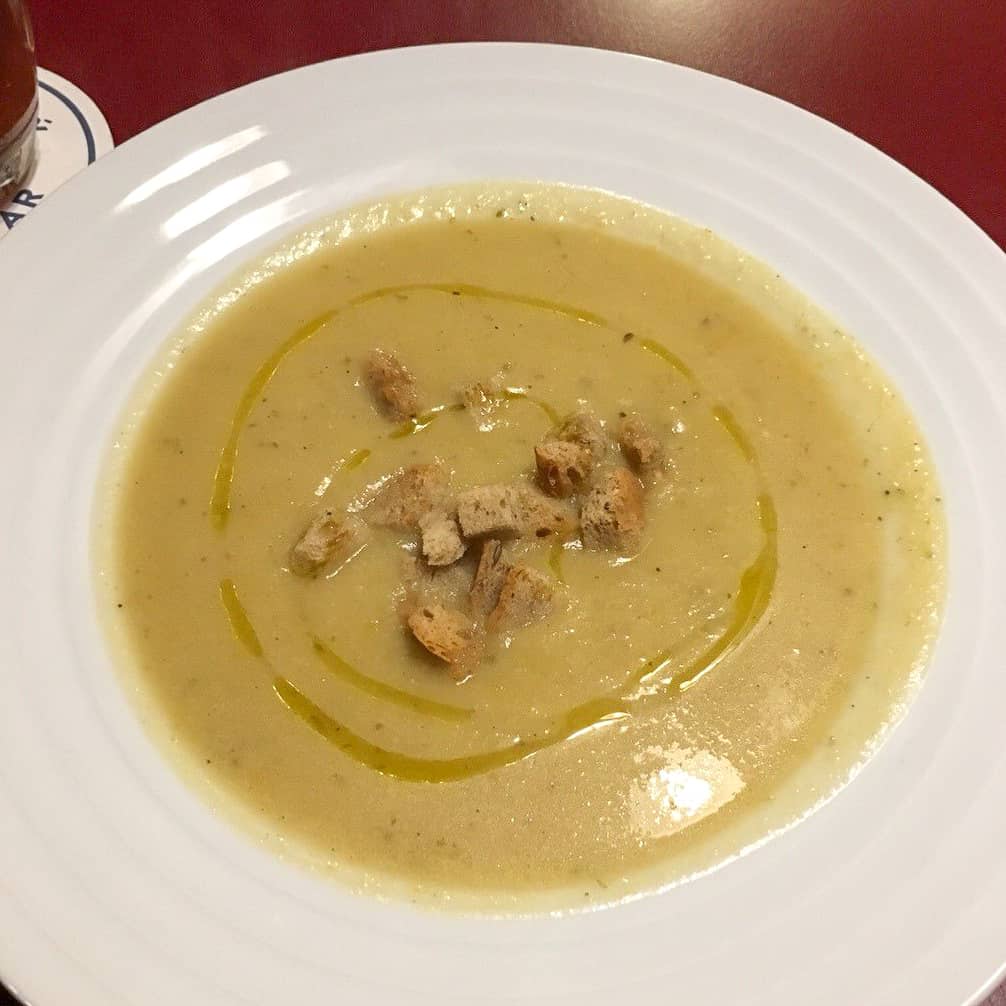
Creamy Cauliflower Soup
The soup of the day was a Creamy Cauliflower Soup with croutons made from traditional Czech bread, garnished with pumpkin seed oil. The soup may not have been a traditional recipe, but it was possibly the best soup we have ever eaten! We encountered toasted pumpkin seed oil in a lot of Czech and Eastern European food on our trip.
We ordered two entrees for our meal, both traditional Czech dishes. The first was Svíčková na smetaně s uzeným tempehem which translates as Czech sauce made from root vegetables and vegetable cream, served with homemade dumplings and cranberry jam. This was absolutely amazing! The sauce was made of root vegetables, carrots, parsnip, onions, and plant-based cream, along with thyme, allspice, and bay leaf, giving it a rich, earthy flavor. The dumplings were dense and chewy, boiled with pieces of brown Czech bread studded throughout (a great zero waste way to use stale bread!). They were delicious and filling dredged through the creamy sauce. Two pieces of simmered tempeh were served in the cream sauce and were rather unremarkable, but the best part was the cranberry jam! This tart-sweet jam gave the whole dish an amazing tang when eaten together in complete bitefuls!
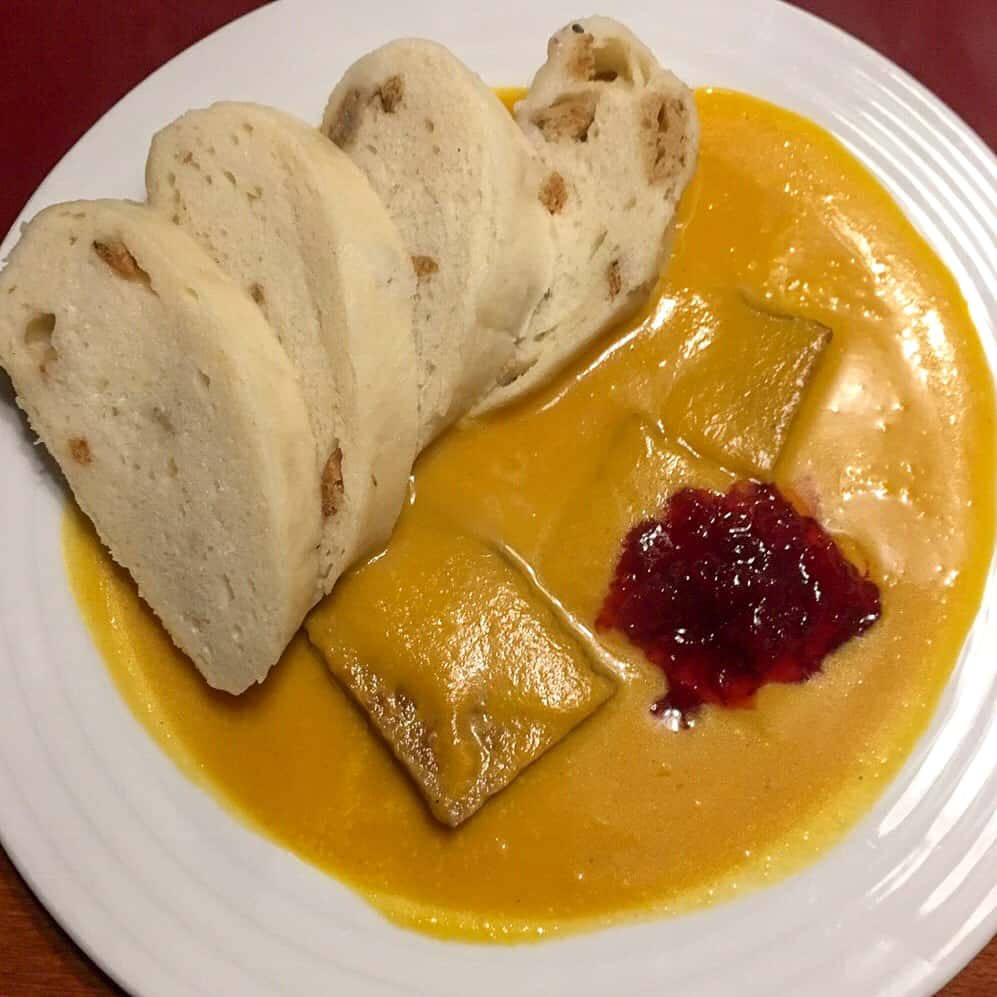
Root Vegetables in Vegetable Cream with Dumplings and Cranberry Jam.
The second dish was Tradiční bramborový guláš, a traditional Goulash (stew) with potatoes, root vegetables, onion, garlic, peppers, garnished with a pickled cucumber and fresh marjoram. This was a rich tomato-based stew flavored with sweet paprika and caraway, full of potatoes and carrots. The dill pickles cut through the richness of the dish and the sauce was perfect for dunking chewy Czech bread into.
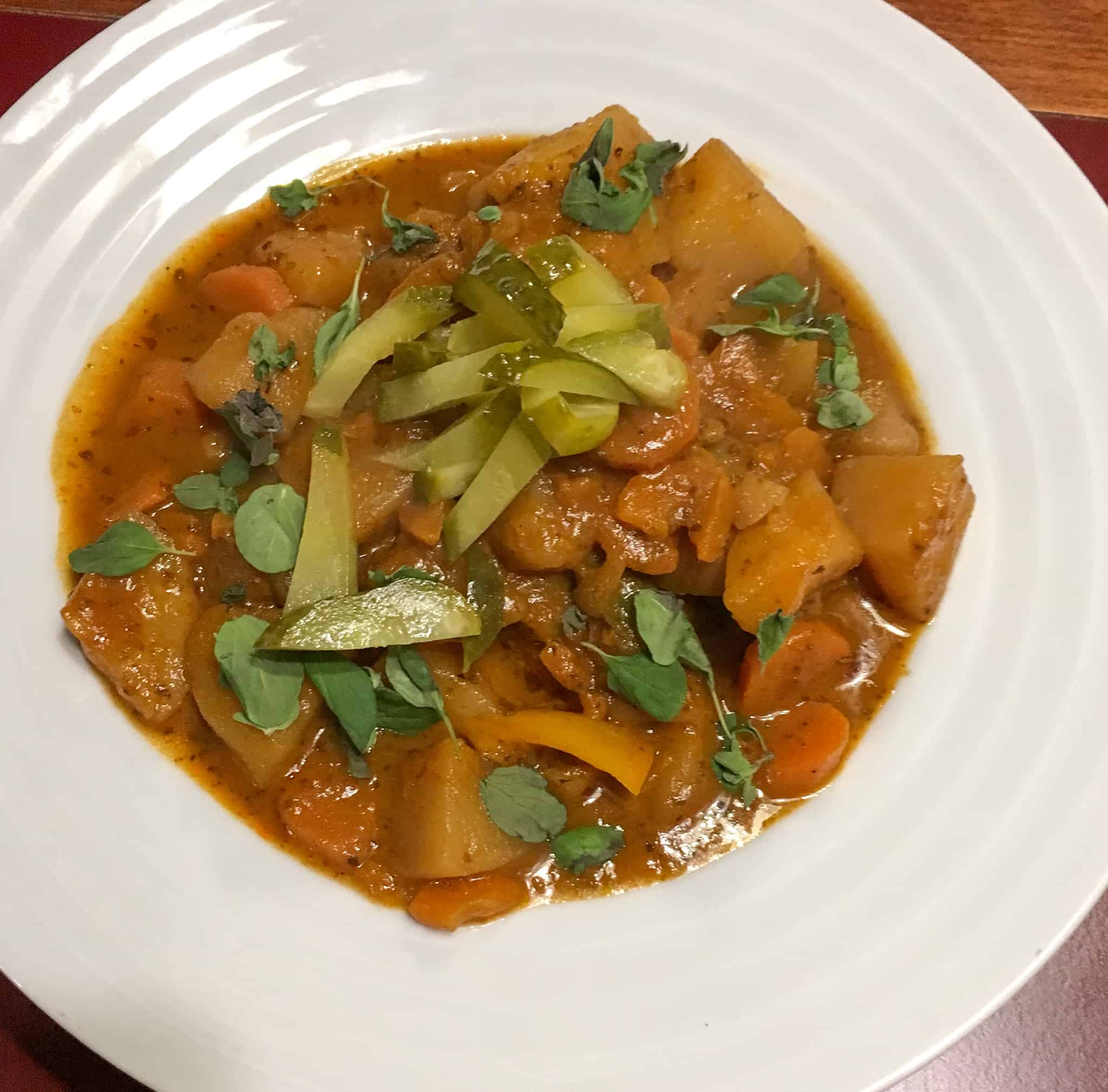
Traditional Guláš.
For dessert, we ordered a traditional Domácí ovocné kynuté knedlíky, which were homemade bread dumplings covered in a thick, rich, sweet-tart plum sauce. The dumplings were the same as those served in the root vegetable sauce in one of the entrées. The plum sauce was incredibly thick and rich like pureed prunes. While delicious, it was much too heavy and dense to have following the same dumpling in an entrée prior!
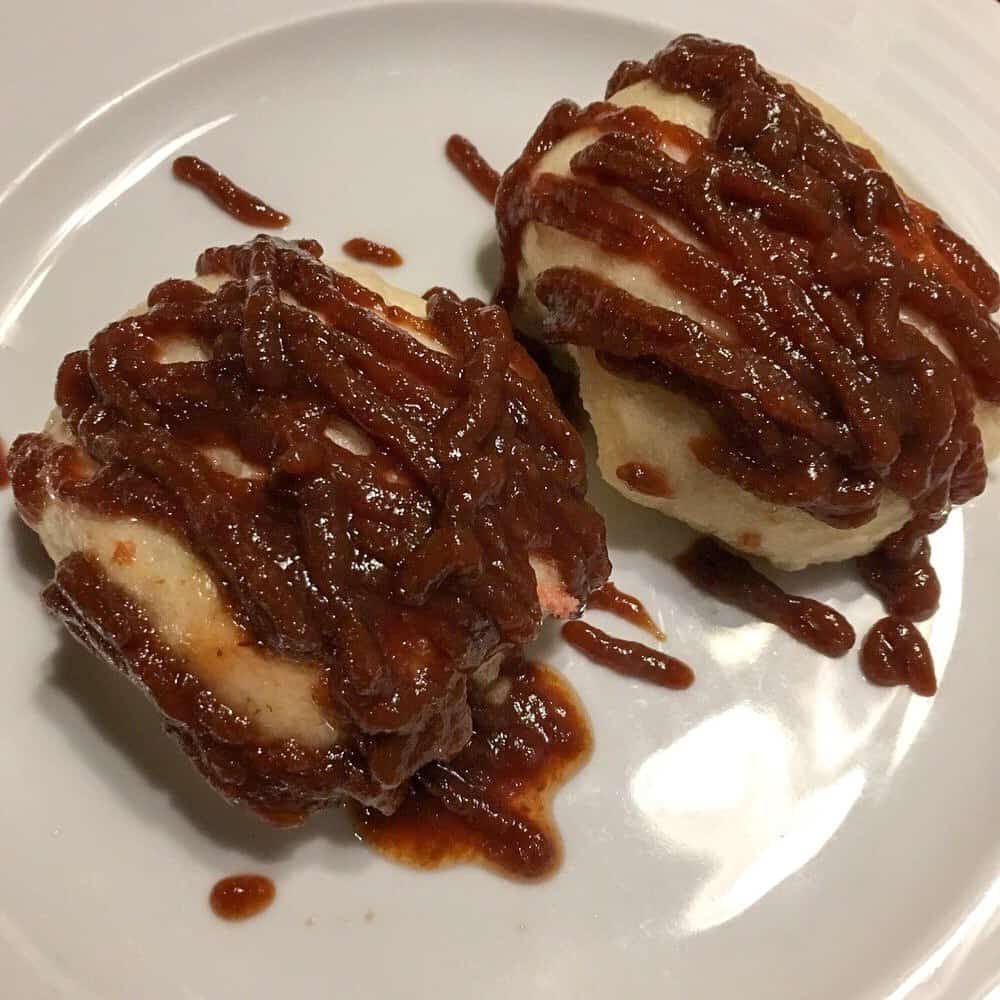
Bread Dumplings with Plum Sauce.
Key Ingredients in Cuisine of the Czech Republic
Traditional Czech cuisine has some specific key ingredients: root vegetables, alliums (onion and garlic), plums, paprika, caraway, mustard seed, and marjoram. The flavors are said to be influenced by German cuisine, from when the Hapsburg’s ruled the region. Therefore, like in Germany, sauerkraut, dumplings, and fried meat cutlets are prevalent in Czech cuisine. The Hungarians introduced paprika and goulash, while fermented and pickled foods came to the region from Eastern Europe. Winters are long and cold, therefore root vegetables and hearty dishes are mainstays.
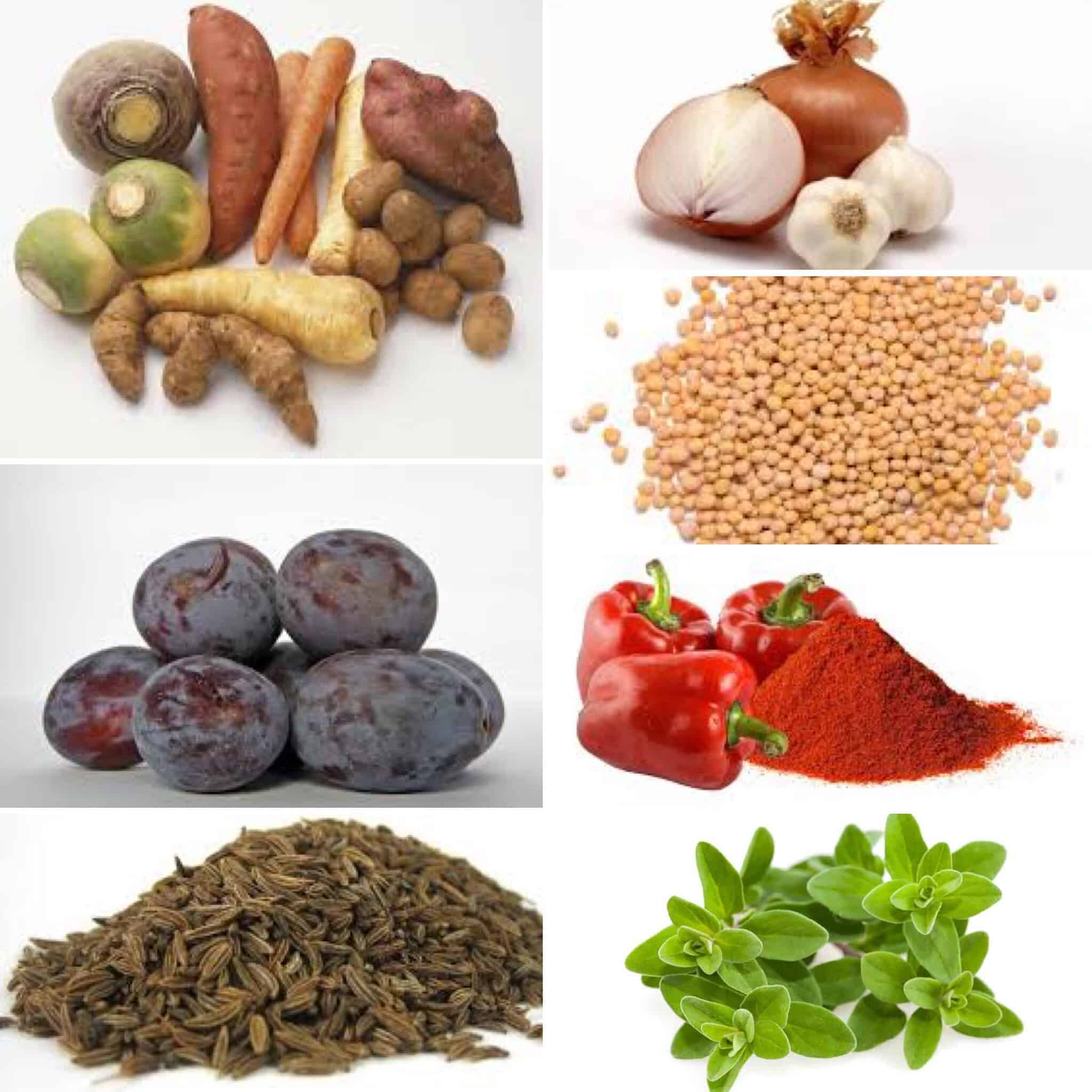
Flavors of traditional Czech cuisine: Root vegetables, plums, caraway seed, aliums (onions and garlic), mustard seed, paprika, and marjoram.
The Soviet occupation had a huge impact on Czech cuisine. From the end of World War II until the fall of Communism in 1989, restauranteurs were, by law, limited to cooking only meals from one cookbook, Recipes for Warm Meals. It is thought that many traditional Czech dishes were lost to posterity from this time. Interestingly, Czechs traditionally ate meat only once a week, but meat consumption increased after the end of the Cold War when the economy improved. However, meat consumption has decreased in the past several years and Prague is now known as one of the world’s most veg-friendly cities.
My version of Czech Tempeh Guláš with Spaetzle
I was inspired to do a tempeh-based Czech guláš after my experience eating traditional food in Prague and researching the flavors and influences of food of this region. Czech guláš is a thick, hearty stew spiced with paprika, caraway seed, and marjoram. It is often made with stew meat but can also be found with root vegetables only. My version uses tempeh instead of meat.

My version of Tempeh Guláš with Spaetzle.
Traditional Czech guláš is made with the key ingredients of root vegetables, onion, garlic, peppers, and garnished fresh marjoram, a rich tomato-based stew flavored with sweet paprika and caraway. Its said to be influenced by the Hungarians, who introduced paprika and their thinner version of soup-like gulyás. German influences, such as bread dumplings, came from when the Hapsburg’s ruled the region.
This dish is made with layers of flavors. To start, simmer cubes of tempeh in a “beefy” flavored vegetable broth, yellow and brown mustard seed, caraway seed, crushed garlic, and bay leaf for 60 minutes. Simmering or steaming tempeh is key to making great-tasting tempeh dishes.

Simmering the tempeh.
While the tempeh simmers, prepare the base of the guláš. Sweat chopped yellow onions in vegetable stock until soft and starting to color before adding chopped garlic, caraway seed, sweet paprika, coconut sugar, tomato paste, bay leaf, marjoram, salt, pepper, and red wine vinegar. Cook this for a few minutes before adding a “beefy” vegetable stock. Add large dice of potato and thick coins of carrots, bring the mixture to a boil, then simmer with the lid on for 30 minutes.
Drain the tempeh and add it to the mixture after this first simmer. Simmer for another 30 minutes and then add coarse crumbs of homemade dark sourdough rye bread and additional marjoram.
I serve this over spaetzle, using a recipe from the Rouxbe Cooking School, garnished with additional marjoram. Czech guláš is typically served with sliced bread dumplings on top, but I like the guláš to be the star of this dish and spaetzle are basically miniature bread dumplings that are lighter and faster to prepare!
This dish is hearty, rich, thick and spicy, just like guláš I ate in Prague. The caraway and rye are very prevalent, as are the onions, garlic, and paprika. The tomato is not overpowering, just offers a rich base. The potatoes and carrots are stewed perfectly and the tempeh holds its form while softening and absorbing the flavors of the dish. Marjoram adds a pop of herbaceousness to liven up an otherwise heavy dish. The spaetzle lightens up the dish as well, as traditional bread dumplings are rather heavy.

My version of Tempeh Guláš with Spaetzle.
Tempeh Guláš with Spaetzle immediately evokes wonderful memories of food, places, and people of one of my favorite places, the Czech Republic. International travel is a great way to meet amazing people and try new ingredients you may never have had before. This dish is wonderful on a cold winter’s night, and I hope it transports you back to one of my favorite cities, Prague!
Dobrou chut (Bon Appetit)!
Czech Tempeh Guláš with Spaetzle
Ingredients
"Beefy" Veggie Stock
- 8 cups vegetable stock
- 1 tbsp vegan Worcestershire sauce
- 5 tbsp Bragg's aminos soy sauce, tamari, or coconut aminos
- 3 tbsp nutritional yeast
- 1 tsp granulated garlic
- 1 tsp granulated onion
- ½ tsp freshly ground black pepper
Tempeh
- 2 8 oz. packages tempeh cut into 1-inch cubes
- 3 cups "Beefy" Veggie Stock add a little more water if needed to cover tempeh in your pan.
- 1 tsp yellow mustard seed
- 1 tsp brown mustard seed
- 1 tsp caraway seed
- 2 cloves garlic crushed
- 1 bay leaf
Guláš
- 1 onion chopped
- water or "Beefy" Veggie Stock as needed to saute onions
- 2 cloves garlic minced
- 1 tsp caraway seed
- 3 tsp paprika preferably Hungarian sweet paprika
- 3 tsp coconut sugar
- 3 oz. tomato paste
- 1 bay leaf
- 1½ tbsp fresh marjoram, chopped or 1½ tsp dry marjoram
- 1½ tsp salt
- freshly ground pepper to taste
- 1 tbsp red wine vinegar
- 5 cups "Beefy" Veggie Stock (whatever remaining amount from what you made at start)
- 3 Russet potatoes peeled and cut into 1-inch cubes
- 2 carrots peeled and cut into ½-inch rounds
- ¾ cup coarse bread crumbs preferably from dark rye bread, use gluten-free or omit if sensitive to gluten
Garnish
- ½ tbsp fresh marjoram, chopped or ½ tsp dry marjoarm
- chopped dill pickle as desired
Instructions
"Beefy" Veggie Stock
- Combine all ingredients and set aside. Will be used throughout recipe.
Prepare Tempeh
- In a large saucepan, add “Beefy” Veggie stock, yellow and brown mustard seed, caraway seed, crushed garlic, and bay leaf.
- Add tempeh cubes to broth mixture and bring to a simmer. Simmer tempeh with lid on for 60 minutes.
Make Guláš
- While the tempeh simmers, prepare the base of the guláš.
- Sweat chopped yellow onions in "Beefy" Veggie Stock or water until soft and starting to color.
- Add chopped garlic, caraway seed, sweet paprika, coconut sugar, tomato paste, bay leaf, marjoram, salt, pepper, and red wine vinegar. Cook this for a few minutes before adding remaining “Beefy” Veggie Stock.
- Add potato and carrots, bring the mixture to a boil, then simmer with the lid on for 30 minutes.
- Drain the tempeh and add it to the mixture after this first simmer. Simmer for another 30 minutes.
Make Spaetzle
- Prepare spaetazle as directed from https://rouxbe.com/recipes/5213-spaetzle-egg-dairy-free
Serve and Garnish
- Remove Bay Leaf.
- Add bread crumbs and mix well.
- Serve over hot spaetzle. Sprinkle with additional marjoram and top with chopped dill pickle, if desired.
Nutrition
Do you like this post? Please share....
If you liked this post, you might like one of these:
Categories:
Tags:

[Trī-māz-ing]
Cindy wants you to be Trimazing—three times better than amazing! After improving her health and fitness through plant-based nutrition, losing 60 pounds and becoming an adult-onset athlete, she retired from her 20-year firefighting career to help people just like you. She works with people and organizations so they can reach their health and wellness goals.
Cindy Thompson is a national board-certified Health and Wellness Coach, Lifestyle Medicine Coach, Master Vegan Lifestyle Coach and Educator, Fitness Nutrition Specialist, Behavior Change Specialist, and Fit2Thrive Firefighter Peer Fitness Trainer. She is a Food for Life Instructor with the Physicians Committee for Responsible Medicine, Rouxbe Plant-Based Professional, and Harvard Medical School Culinary Coach, teaching people how to prepare delicious, satisfying, and health-promoting meals.
She provides health and lifestyle coaching at Trimazing! Health & Lifestyle Coaching. Cindy can be reached at info@trimazing.com.
Subscribe to the Trimazing Blog
Receive occasional blog posts in your email inbox.
Subscribe to the Trimazing Blog
Receive occasional blog posts in your email inbox.





















